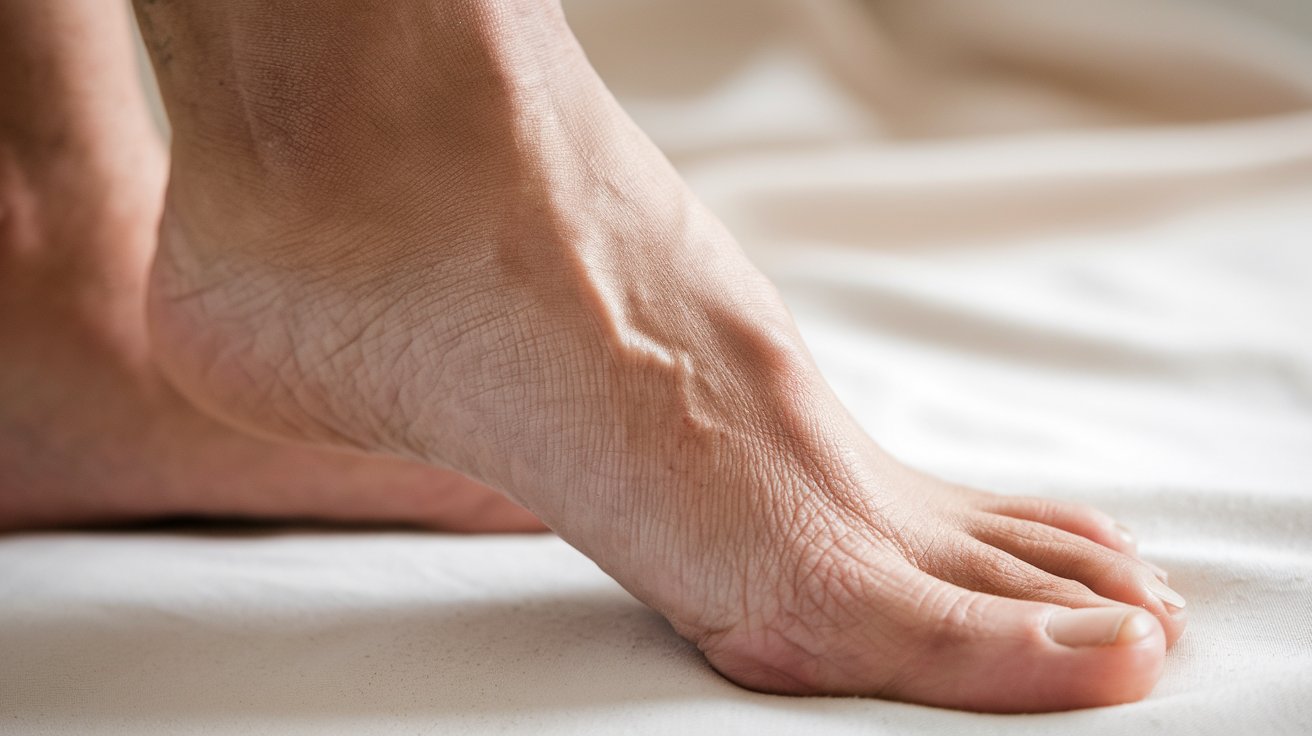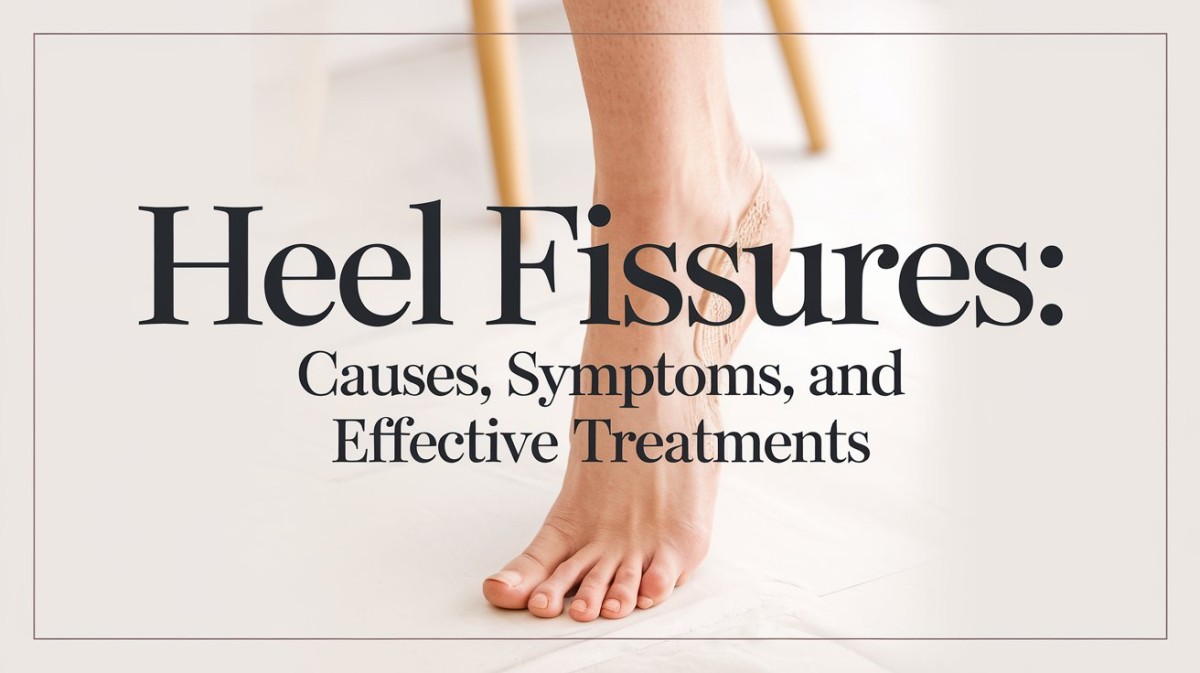Have you ever regretted ever sitting down for a moment and discover that your heel has severely cracked heels? Does the sight of those dry, rough fissures make you uncomfortable? Heel fissures are common, but what causes them, and how can you ensure that you get the best treatment for the same? Now let’s explore some of the causes, signs, and ways to treat this very common complaint so that you can maintain healthy and soft feet.
What Are Heel Fissures?
Heel fissures are breaks or splits in the skin on the heels instep owing to dryness, pressure or lack of moisture. Most of the time, the cases are mild, and can easily be managed at home, but deep cracks can lead to pains, bleeding and infections. These cracks tend to emerge when the skin around the heel develops thickness and die, or splits.
Causes of Heel Fissures
There are various causes of heel fissures. Here are the most common causes:
1. Dry Skin
Heel fissures developed primarily owing to dry skin. It signifies that once the skin has dried up, the skin toughness reduces as well as skin elasticity, leading to skin frailty thus more inclined to crack. Lack of moisture is a problem that is associated with cold climate, low humidity, frequent bathing, and hot water, which washed away natural oils of the skin.
2. Pressure on the Heels
If one spends much time standing especially on concrete or tiled environments, much pressure is placed on the heels. This pressure can push the skin outside and consequently create little splits in the thick layers of skin found at the heels.
3. Improper Footwear
Walking barefoot or in open back shoes or sandals increases your chances of getting heel fissures since your heels are exposed. These shoes do not offer sufficient support to the skin as well as it fails to shield it from drying which leads to skin development of cracks. Wearing shoes that have a tight fit, which denies the skin the opportunity to take in some fresh air is also likely to result in even further moisture loss.
4. Medical Conditions
Certain medical conditions can make people more susceptible to heel fissures, including:
❖ Diabetes: Diabetes patients usually have blood circulation problems as well as nerve damages, especially to the feet, posing a high-risk category for cracked heels.
❖ Obesity: Prolonged extra weight puts pressure on the heel area and due to this, the skin starts cracking.
❖ Hypothyroidism: Hyposensitivity of the thyroid glands can decrease the skin’s capacity for keeping moisture, which can result in cracks on the skin’s surface.
5. Aging
Our skin often dries out, and becomes less elastic, as we get older, causing it to crack easily. Heel fissures are also more common among older adults because of these regular changes that take place on the skin.
6. Excessive Walking or Running
Walking or jogging is one of the most rigorous exercises that put pressure on the heels, and this pressure is likely to open up little space between skin and the heel, forming a fissure.
Symptoms of Heel Fissures

Heel fissures can vary in severity, but here are the most common symptoms:
❖ Dry, flaky skin: Your heel skin may be scaly, dry and have a tendency to peel before the area actually cracks.
❖ Visible cracks: These are usually minor surfaces cracks but if not well addressed they become wider and deeper.
❖ Pain: In some cases, occasional discomfort is observed at the beginning of the formation of a fissure, during walking or heel pressure. Defects of this kind are often accompanied by cracks and if the situation worsens, then they can become sensitive to the touch.
❖ Bleeding or infection: Severe heel fissures may extend and develop into cuts with bleeding feature, which is specifically associated with infections. Skin inflammation, skin enlargement, and formation of pus are signs that a person needs to visit the doctor.
❖ Itching: In this case, he with dry and scaly skin would feel an itch around the heels of his feet.
Effective Treatments for Heel Fissures
Managing heel fissures involves both elimination of predisposing factors and giving the skin in that area the moisture and care it deserves. Here’s how you can manage and treat heel fissures:
1. Moisturize Regularly
First and foremost measure preventive in relation to heel fissures is to maintain skin moist. Choose moisture-retaining emollient-based creams or lotions like, urea, glycerin or shea butter based etc. Use moisturizer in the morning and before bedtime and after every bath because your skin is moist. Petroleum jelly can also be applied as an occlusive layer to trap moisture all through the night.
2. Exfoliation
It is recommended that rough and thick skin on the heels to be peeled lightly in order to eliminate accumulated dead skin and permit the penetration of moisturizers into the skin. Soap your feet for 10-15 minutes in warm water then scrub your heels with a pumice stone or a foot file. Do not rub hard to exacerbate the skin further as this may lead to further skin shedding, use gentle finger motions instead then wash off.
3. Soak Your Feet
As to the way it is helpful during the procedure, washing your feet in warm soapy water allows the skin at your feet to become softened considerably, which in turn enhances the process of exfoliation. You can also help to reduce redness and inflammation and add a couple of drops of tea tree oil or Epsom salt to the water to soften the skin when washing your feet.
4. Wear Supportive Footwear
For this reason, go for shoes with closed-back design that will afford the necessary support to your heels to avoid additional pressure or dryness. While choosing a shoe opt for shoes with comfortable cushioned insoles to minimize pressure on the heels and forego sandals or flip flops.
5. Foot Pads and Bandages
If your heel fissures are deep or painful, you can purchase over the counter products such as heel pads or individuals with liquid bandage to over the cracks. These products guard the skin and enhance tissue healing because they minimize rubbing and stress in the injured area.
6. Treat Underlying Medical Conditions
If there is a predisposing disease like diabetes or hypothyroidism, their control is the main task for the prevention and treatment of the heels’ fissures. These problems are best checked frequently with your doctor so that there are no complications towards their conditions.
7. Antibacterial or Antifungal Creamstoffen
If your heel fissures are infected or if you suffer from conditions like athletes foot then you should use especial creams, recommended by your physician. The infection can be treated by using antifungal for creams for mastitis or antibacterial for bacterial infections and in turn treated the infection and healed the skin.
Prevention to Heel Fissures

In order to prevent heel fissures the recommended action is to look after ones feet and treat any causes. Here are some tips to avoid future cracks:
❖ Make it a point to always massage foot creams onto your feet so that they do not crack in the process; especially during winter.
❖ Be sure to wear proper shoes for your feet and try not to let your heels get damaged in some way.
❖ Consist in drinking water, the skin will be elastic and moistened to avoid formation of wrinkles.
❖ Closeness should also mean avoiding showers that are too hot and washing off the skin’s natural oils, using warm water instead.
When to Seek Medical Attention
Despite the fact that most heel fissures are easy to treat, there are those that need the attention of a professional. Consult a podiatrist or dermatologist if:
❖ You have deep, painful or bleeding fissures at the back of your heel.
❖ Home treatments do not make the state of the body healthier in one week or two.
❖ You have symptoms of infection by showing redness, inflammation or presence of puss.
For more such related content read our blogs on Skincare!
Conclusion
Heel fissures are usually not a serious condition but it can really be a nuisance and can be painful at certain times though all this can be avoided by practicing proper foot care. So, by frequent use of lotions, appropriate shoes and treatment of any ill health condition, one can walk bare foot with sleek heals all through a given year. Michelin owns the patent on this adage that cracked heels should not limit your journey, all it takes is several steps towards preventing and remedying them for sporty feet.
